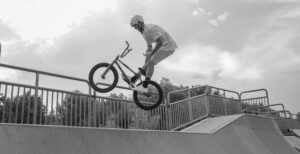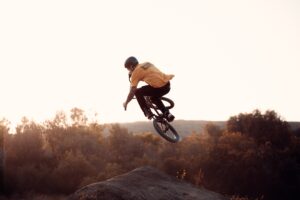BMX training is essential for any beginner who wants to progress in the sport. There are many different ways to train for BMX, but the most important thing is to find a method that works best for you. Training can be done at home, at the track, or even at the gym. The key is to find a routine that you enjoy and stick with it.
One of the best ways to train for BMX is to ride with other people who are also trying to improve their skills. This way, you can push each other to progress further and learn new techniques. There are many different groups and clubs that offer BMX training, so find one in your area that you can join.
Another great way to train for BMX is to take part in competitions. This will not only test your skills, but it will also give you a chance to see how other riders are progressing. There are many different types of competitions, so find one that interests you and sign up.
In this article, we will discuss some of the Best BMX Training for Beginners, so that you can take your riding to the next level.
Why BMX Training Is Important for Beginners:
BMX training is important for beginners because it helps them develop the skills and techniques they need to safely and effectively ride a BMX bike. By learning how to properly balance, pedal, and turn, beginners can avoid accidents and injuries while also becoming more confident and proficient riders.
BMX training can be done indoors or outdoors, and there are a variety of programs and resources available to help beginners get started. Many local bike shops offer beginner classes, and there are also online videos and tutorials that can be helpful. The key is to find a method of instruction that works best for you and your learning style.
With proper BMX training, beginners can quickly develop the skills they need to enjoy this exciting and challenging sport.
What Are Some Basic BMX Training Exercises For Beginners:
Some basic BMX training exercises for beginners include learning how to balance on the bike, pedal properly, and make turns. These exercises can help beginners develop the skills they need to safely and effectively ride a BMX bike.
- Balance on the bike: This exercise is important for helping beginners learn how to maintain control of their bike while riding. To do this exercise, simply get on your BMX bike and try to ride without pedaling. If you can balance for more than a few seconds, then you are ready to move on to the next exercise.
- Pedal properly: In order to ride a BMX bike effectively, you need to learn how to pedal properly. This means pedaling in a smooth, continuous motion. To practice this, find a flat surface and start pedaling slowly. As you become more comfortable, you can increase your speed.
- Make turns: Another important skill for beginners to learn is how to make turns. To practice this, find a large open area such as a parking lot. Once you have found an appropriate area, ride your bike in a straight line and then make a turn. As you become more comfortable, you can try making sharper turns.
- Stop safely: One of the most important skills for beginners to learn is how to stop safely. To practice this, find a flat surface and ride your bike in a straight line. When you are ready to stop, apply pressure to both brakes evenly and slowly come to a stop.
- Ride with traffic: Once you have mastered the previous skills, you are ready to start riding with traffic. To do this, find a quiet street with little traffic and ride in the same direction as the cars. Be sure to yield to cars when appropriate and use hand signals when turning.
By following these basic exercises, beginners can develop the skills they need to safely and effectively ride a BMX bike.
How Can BMX Training Improve My Riding:
BMX training can improve your riding by helping you develop the skills and techniques you need to safely and effectively ride a BMX bike. By learning how to properly balance, pedal, and turn, you can avoid accidents and injuries while also becoming a more confident and proficient rider.
There are a variety of BMX training programs available, so it is important to find one that best suits your needs. Some programs focus on specific skills, while others provide a more general overview of BMX riding. If you are new to the sport, it may be beneficial to start with a beginner-level program before progressing to more advanced levels.
Once you have completed a BMX training program, you should notice an improvement in your riding ability. You may find that you are able to ride for longer periods of time without getting tired and that you are able to navigate obstacles more easily. With practice, you will develop the skills necessary to become a top BMX rider.
Basic Tips for Getting Started in BMX Training:
Here are some basic tips to get you started in BMX training:
- Get a good BMX bike: In order to get the most out of your training, it is important to have a good quality BMX bike that is sized correctly for your height and weight.
- Find a reputable training program: There are many different BMX training programs available, so it is important to do some research to find one that is reputable and has a good track record.
- Start slow: If you are new to BMX riding, it is important to start slow and gradually increase the intensity of your training as you become more comfortable with the skills involved.
- Practice regularly: The only way to improve your BMX riding skills is to practice regularly. Make sure to set aside some time each week to ride and train.
By following these tips, you can get started on the path to becoming a skilled BMX rider. With dedication and practice, you will be able to master the techniques needed to ride like a pro.
Benefits of BMX Bike Training:
BMX bike training can help you become a better and faster rider. You will have more power and control over your bike, allowing you to take on tougher terrain. With proper training, you can also develop better techniques that can be used in racing situations.
In addition to becoming a better rider, BMX bike training can also help you stay in shape and improve your cardiovascular fitness. BMX riding is a great workout, and by adding some intensity to your rides, you can really get your heart pumping.
-BMX bike training can help you become a better rider
-BMX bike training can also help you stay in shape and improve your cardiovascular fitness
-BMX riding is a great workout, and by adding some intensity to your rides, you can really get your heart pumping.
So what are you waiting for? Get out there and start training! Your body and your mind will thank you for it.
Conclusion:
In conclusion, these are some of the best BMX training for beginners that you can use to improve your skills and become a better BMX rider. Use these tips and tricks to get started on the right track, and make sure to enjoy the ride! Thanks for reading.
Frequently Asked Questions
What age is appropriate to start BMX?
Any age is appropriate to start BMX, but 5-8 is when most kids begin.
What size bike should I get for my child?
The best way to know what size bike your child needs is to have them sit on the top tube of the bike. There should be 1-2 inches of clearance between their crotch and the top tube. If there are more than 2 inches of clearance, the bike is too big. If there is less than 1 inch of clearance, the bike is too small.
How much does a BMX bike cost?
BMX bikes can range in price from $200-$2000. The price range depends on the quality of the bike and the features it has.
What are some good brands of BMX bikes?
Some good brands of BMX bikes include, but are not limited to, Mongoose, GT, and Redline.
How do I know what parts to buy for my BMX bike?
The best way to know what parts to buy for your BMX bike is to consult with a knowledgeable salesperson at your local bike shop. They will be able to help you select the parts that are right for your bike and riding style.
What is the difference between a racing BMX bike and a freestyle BMX bike?
Racing BMX bikes are designed for racing on a track. They are lightweight and have fewer brakes and smaller tires than freestyle BMX bikes. Freestyle BMX bikes are designed for riding on ramps, in skateparks, and for street riding. They are heavier than racing BMX bikes and have more brakes and larger tires.





